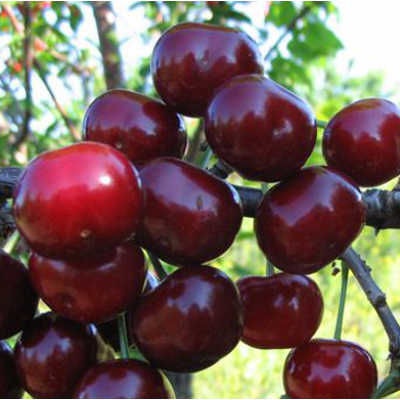
- Authors: A. Sychov
- Barrel type: wood
- Growth type: medium-sized
- Crown: moderately thick, globular, compact
- Escapes: very similar to cherry
- Leaves: dense, leathery
- Flowering and fruiting type: mixed, most of the crop is formed on bouquet branches
- Fruit size: large
- Fruit shape: rounded
- Fruit color: dark red
The Khodos hybrid is winter hardiness, large-fruited and excellent taste. Berries are consumed fresh, used for making jams, marmalade, candied fruits, decorating cakes and pies. They can be used in industrial bakery and confectionery industries.
Breeding history
Cherry-cherry hybrid bred by breeder A. Sychov.
Description of the variety
The tree is medium-sized, reaching a height of 3-4 m, the crown is compact, spherical, not very dense. The branches are at a 60-degree angle from the trunk and are covered with smooth dark brown bark. The leaves are large, pointed, dense and leathery, bright green. The flowers are large, white, collected in inflorescences. Flowering times may vary from region to region. Differs in a high rate of growth of shoots. Duke has a lifespan of about 30 years.
Fruit characteristics
The berries are large, weighing 6.8-7 g, rounded, slightly flattened at the top, dark red. The pulp is quite dense and tender, with a cherry aroma, the stone is large, detachable. Good transportability, stored in the refrigerator for about 2 weeks.
Taste qualities
Dessert taste, excellent, sweet, with sourness.
Ripening and fruiting
The tree begins to bear fruit 4-5 years after planting, and then regularly. The species is considered average in terms of ripening, the harvest ripens in early July, in temperate climates a little later.

Yield
On average, 12-15 kg per plant, under favorable conditions, remove 25-30 kg.
Growing regions
The hybrid is suitable for planting throughout Russia, with the exception of the northernmost regions. For colder climates, this species is grown in the form of a bush - this makes it easier to make shelter for the winter.
Self-fertility and the need for pollinators
A self-fertile variety, additional pollinators are required to obtain a crop. Pollinators can be cherry and cherry trees, as well as hybrid forms - dukes. Self-fertile varieties are suitable: Lyubskaya, Molodezhnaya, Ovstuzhenka, Businka, Priusadebnaya, Annushka, Donchanka, Iput. From pollination of cherries, the yield becomes slightly higher.
Landing
The plant is planted in sunny, wind-protected areas with deep groundwater. The culture is contraindicated in shade, lowlands and swampy soils. Acidic soils are neutralized with chalk or lime. Bushes are placed at a distance of 5 m from other seedlings and fruit trees.
A hole is dug in advance, for spring planting - in the fall. It is made with a diameter of 60-70 cm, and a depth of about 60 cm. For a seedling, a nutrient mixture is prepared from humus - 3 kg, wood ash - 200 g, superphosphate - 50 g, potassium sulfate - 40 g and garden soil. The resulting substrate is filled with 75% of the total volume. Before this, for 1-2 days, the roots of the cherry are kept in a slightly pink solution of potassium permanganate, 3 hours before transferring to the ground, the root system is placed in a growth stimulator: "Kornevin", "Zircon". The planting plan is the same as for other cherries and cherries. After planting, watered with 20 liters of water, then moistened weekly.Up to 5 years old trees need regular watering. In young dukes, the top and skeletal branches are pruned: at least 60 cm should remain from the ground surface to the extreme point. The next year, all branches are cut off by about 1/3.


Growing and caring
Duke Hodos is an unpretentious culture, caring for it is easy. It is enough to follow simple agricultural techniques: first remove all weeds, then water and loosen. Watering should be done regularly, but in moderation: one adult tree takes 20-40 liters of water; in dry periods, the frequency of watering is increased. The variety is considered drought-resistant, but with a lack of moisture, the berries will not be so juicy. After watering, the soil is loosened and mulched with hay.
The hybrid practically does not require additional fertilizing: it bears fruit perfectly on soils of medium nutritional value. It is enough to dig up the ground around the trunk in the fall and mulch with grass.
The crown needs regular pruning, since its thickening has a bad effect on the quality of the crop. A young tree grows very quickly, but with the onset of fruiting, growth almost stops. Rejuvenating pruning is done every 5 years, removing shoots up to the height of a 4-year-old tree.


Disease and pest resistance
The culture has a high immunity to pests and diseases. The plant resists the main diseases of cherry: coccomycosis and moniliosis. Not afraid of the cherry fly. It can be damaged by powdery mildew - for prevention, spray with an iodine solution - 10 ml of iodine per 10 liters of water. This procedure is carried out several times with an interval of 3 days. When fruit rot appears, they are sprayed with an infusion of garlic, wood ash or a solution of soda. From rodents, the stem is covered with an iron mesh or wrapped with spruce branches.
Requirements for soil and climatic conditions
The variety is highly winter-hardy, withstands frosts down to -27 degrees, neither bark nor flower buds freeze out. In regions with colder winters, plants need light shelter. Young trees are insulated in the first few years. Duke Hodos is heat-resistant and drought-tolerant. The most suitable soils: chernozem, loamy, gray forest with neutral acidity.
































































